Abstract
Background:
Flexural strength of prosthesis made with dental composite resin materials plays an important role in their survival. The aim of this study was investigating the effect of nanoclay fillers and Poly (methyl methacrylate)-grafted (PMMA-grafted) nanoclay fillers loading on the flexural strength of fiber-reinforced composites (FRCs).
Materials and Methods:
Standard FRC bars (2 × 2 × 25 mm) for flexural strength testing were prepared with E-glass fibers and a synthetic resin loaded with different quantities of unmodified nanoclay and PMMA-grafted nanoclay filler particles (0% as control group, 0.2%, 0.5%, 1%, 2%, 5%). Flexural strength and flexural modulus were determined. The data were analyzed using 2-way, 1-way ANOVA and post hoc Tukey's test (α = 0.05). The fracture surfaces were evaluated by Scanning Electron Microscopy.
Results:
For groups with the same concentration of nanoparticles, PMMA-grafted filler-loaded group showed significantly higher flexural strength, except for 0.2% wt. For groups that contain PMMA-grafted nanoclay fillers, the 2% wt had the highest flexural strength value with significant difference to other subgroups. 1% wt and 2% wt showed significantly higher values compared to control (P < 0.05). None of the unmodified nanoclay particles loaded group represented statistically higher values of flexural strength compared to control group (P > 0.05). Flexural modulus of 2%, 5% wt PMMA-grafted and 0.5%, 1%, 2%, 5% wt unmodified nanoclay particles-loaded subgroups decreased significantly compared to control group (P < 0.05).
Conclusions:
PMMA-grafted nanoclay filler loading may enhance the flexural strength of FRCs. Addition of unmodified nanoparticles cannot significantly improve the flexural strength of FRCs. Addition of both unmodified and PMMA-grafted nanoclay particles in some concentrations decreased the flexural modulus.
Keywords: Fiber-reinforced composite, flexural modulus, flexural strength, nanoclay particle
INTRODUCTION
The roots of fiber-reinforced composites (FRC) go back to the late 1990 and since then FRCs have been used in the field of restorative dentistry.[1] A reason for their acceptance among clinicians was their mechanical properties which can be optimized to be equal to dentin or bone.[2,3] Fibers are used to reinforce the polymeric-based dental materials[4] and this reinforcing capacity depends on fibers orientation. The use of FRCs has been increasing in all fields of dentistry and can be used as removable prosthodontics, periodontal splints, orthodontic appliances, posts, and inlay and onlay fix prosthesis.[5,6] The physical and mechanical properties of FRCs made prosthesis and restorations highly depend on the properties of fibers and polymeric matrix.[1] It has been shown that fibers can dramatically enhance the stiffness, strength, and fracture resistance of FRCs and this enhancement has been proved to be affected by fibers’ direction, fibers’ quantity and their adhesion to polymeric matrix.[7] Different types of fillers and matrices have been proposed to improve the mechanical properties of FRC and among them glass fibers are seem to be the material of choice as it shows an appropriate esthetic properties and also can be efficiently bonded to dimethacrylate.[8]
For a long time, the use of FRC has been restricted to short-span bridges. Many studies declare that the main drawback of FRCs that hinders their use in long-span bridges is their low flexural strength.[9] Nemours studies represented that the quantity, quality, and direction of fibers can influence the flexural and transverse strength of FRCs.[10–12] On the other hand, the properties of FRCs similar to other composite materials are affected by many factors, including shape, size, quantities, and surface properties of the fillers as well as continuous phase properties.[13–15]
Along with significant developments in the field of nanotechnology, nanoparticles’ use is growing widely in many dental materials. The role of these particles in improvement of mechanical properties of composite materials has been proved.[16–18] Nanoclay particles has been used for enhancement of the flexural strength and tensile toughness properties of nanocomposites.[19] Montmorillonite (MMT) is one of the available forms of nanoclay and it has been shown that it could increase the mechanical properties of polymers greatly.[16,20] Montmorillonite consists of platelets with an inner octahedral layer sandwiched between two silicate tetrahedral and this architecture has been claimed to impede crack propagation and may enhance the flexural strength consequently.[21] Also, the lower density of nanoclay particles compared to other nanoparticles can significantly decrease the overall weight of resin phase which is a great advantage.[22] Using nanoparticles in modified form could enhance mechanical properties of dental adhesives[23] and nanocomposites.[18]
By assuming that flexural strength of FRCs is their main drawbacks in long-span bridges, this study was designed to investigate the effect of adding nanoclay particles in unmodified and modified forms to resin matrix on flexural strength of FRCs.
MATERIALS AND METHODS
Samples classification
Following groups were considered to be tested in this study: Unmodified nanoclay particle group: Addition of 0.2%, 0.5%, 1%, 2%, and 5% by weight of unmodified nanoclay particles to synthetic resin to make the subgroups each contain 10 specimens. Poly (methyl methacrylate) (PMMA)-grafted nanofiller group: Addition of 0.2%, 0.5%, 1%, 2%, and 5% by weight PMMA-grafted nanofiller to resin to make subgroups each containing 10 specimens.
Control group: 10 FRC samples without nanofiller particles.
Synthesis the nanoclay particles
In this study, Cloisite Na+ (montmorillonite, typical dry particle size 90% less than 13 μm, Cloisite Na, Southern Clay, USA) particles in two forms (unmodified and poly [methyl methacrylate]-grafted-nanoclay) were added to a synthetic resin matrix. Unmodified nanoclay is hydrophilic and the producer had not performed any treatment and/or surface modification on it.
In order to prepare the modified nanoclay particles, first, clay particles were spread in water to separate the platelets. Poly (acrylic acid) (PMAA) and poly (methacrylic acid) (PAA) were grafted onto the pristine Na-MMT nanoclay (Cloisite Na+) through the free radical polymerization of acrylic acid and methacrylic acid monomers in an aqueous media in the presence of ammonium persulfate as initiator. A reactive surfactant (AMPS) was also used in the reaction to provide active sites on the surface of the nanoclay particles. The grafting polymerization reaction was carried out at 70°C.[22]
Resin and nanofiller combination
After drying and milling, various quantities of the prepared PMAA-grafted nanoclay and the unmodified nanoclay were added to a synthetic resin matrix. Table 1 represents the resin ingredients. In order to ensure the appropriate distribution of filler particles and to prevent their agglomeration, an ultrasonic device (Sonopuls, Germany)) was used. The exfoliation of nanoclay particles in resin was analyzed by X-ray Diffractometer (XRD) (Philips X′Pert-MPD) using the Ni-filtered CuKa radiation. Fourier-Transform Infrared Spectrophotometer (FTIR) (Bomem, MB100) was utilized to identify the functional groups of the methyl methacrylate chains on nanoclay particles.
Table 1.
Synthetic resin ingredients
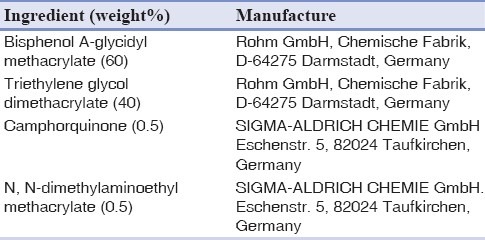
Sample preparation
Before sample preparation, the diameter of light-curing device (bluephase - Ivoclar Vivadent) tube with 500°mW/cm2 intensity was measured. According to the diameter of the tube, a metal mold was divided to three equal parts which allowed the different parts of the mold to be exposed equally.
E-glass fibers (Iran Polymer and Petrochemical Institute) were located and fixed on aluminum foils to prevent any probable movement. Fibers were stained by the appropriate resin for different groups, respectively, as the surfaces of the fibers were completely moist. The 2 × 2 × 25 mm metal mold was put on a glass block. Fibers were divided to equal parts with 25 mm length and then three of them were collected and located on one metal mold. Another glass block was placed on the mold to allow the surfaces of the samples to become smooth. Then, the curing procedure was done for 240 seconds for each sample (40 seconds for each side). Finally, all samples were removed from metal mold and polished by sand paper. All mentioned procedures were done similarly for all samples with different percentage of 2 types, nanofillers and control group. Then, samples were kept in distilled water at room temperature for one week.
Flexural strength test
The three point flexural test was done using universal testing machine (Santam, Tehran, Iran) with the crosshead width of 2°mm and speed of 1°mm/minute.
Finally, the flexure strength was calculated by the following formula:

P: the amount of applied force at the time of fracture
l: bar length
b: sample's width
d: sample's thickness
Then, the elastic modulus was determined using the stress strain curve.
Data were analyzed using Two-Way ANOVA, One-Way ANOVA, and post Hoc Tukey's test with SPSS Version 15 Software.
The failed surfaces were evaluated by Scanning Electron Microscopy (Philips XL30, Philips, The Netherlands).
RESULTS
Table 2 represents the flexural strength values (Megapascal) of FRCs that contain two types of filler with different percentages.
Table 2.
Flexural strengths (MPa) of FRCs contain two types of fillers with different percentages
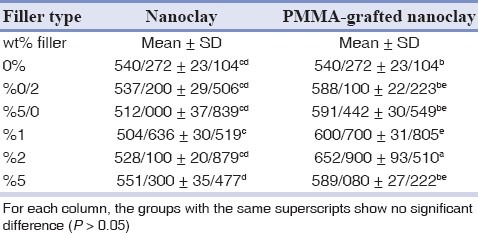
It was shown that in different groups with the same concentration of nanoparticles, the flexural strength of FRC groups containing PMMA-grafted nanoclay particles was significantly higher than FRC groups containing unmodified Nanoclay-particles, except for 0.2% wt groups.
For groups containing PMMA-grafted nanoclay fillers, the 2% wt had the highest flexural strength value with significant difference to other subgroups. 1% wt and 2% wt showed significantly higher values compared to control (P < 0.05). None of the unmodified nanoclay particles-loaded group represented statistically higher values of flexural strength compared to control group (P > 0.05).
Table 3 represents the flexural modulus (GPa) of FRCs that contain two types of filler with different quantities.
Table 3.
The flexural modulus (GPa) of FRCs contain two types of fillers with different quantities. For each column, the groups with the same superscripts showed no significant difference (P > 0.05)
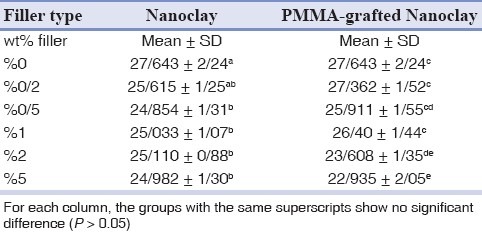
The groups with the same concentrations of two types of nanoparticles showed no significant differences in flexural modulus, except for 5% wt that unmodified Nanoclay-particles added group showed significantly higher values.
Figures 1 to 3 represent the stress strain curves of different groups.
Figure 1.

Stress-strain curves of FRC group contain unmodified nanoclay particles
Figure 3.
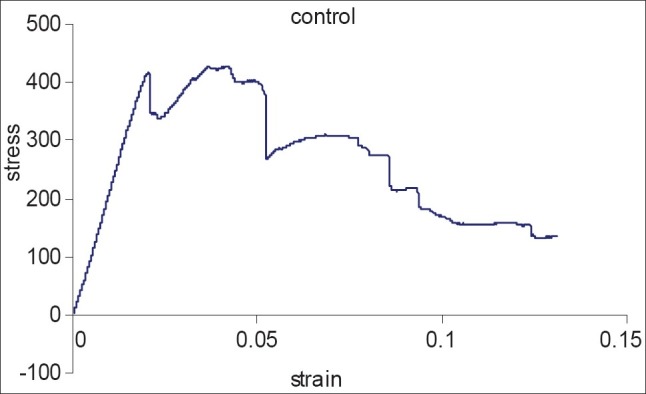
Stress-strain curve of control group contain no particle
Figure 2.

Stress-strain curves of FRC group contain modified nanoclay particles
SEM images of samples at their fractured surfaces are shown in Figures 4 to 6.
Figure 4.
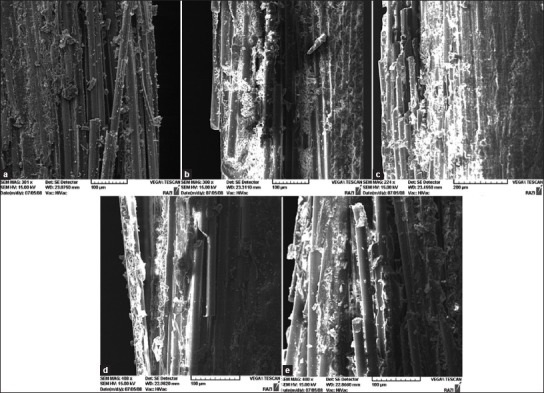
SEM micrographs of fractured surfaces of fiber-reinforced composites contained unmodified nanocaly particles. (a) 0.5% wt nanofiller, (b) 0.2% wt nanofiller, (c) 2% wt nanofiller, (d) 1% wt nanofiller, (e) 5% wt nanofiller
Figure 6.
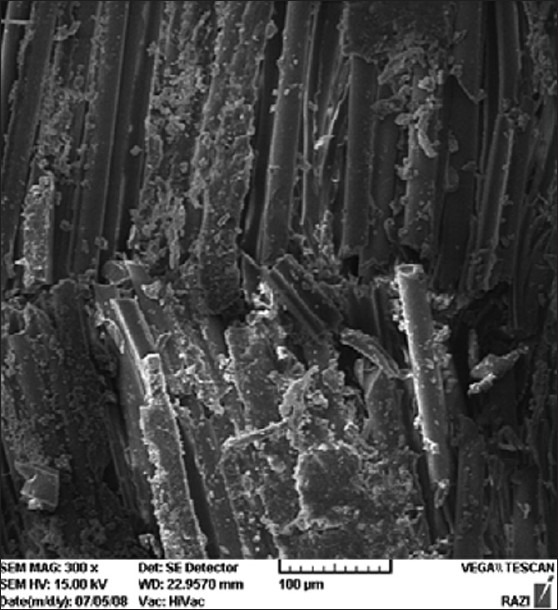
SEM micrograph of fractured surface of fiber-reinforced composites contained no particles
Figure 5.
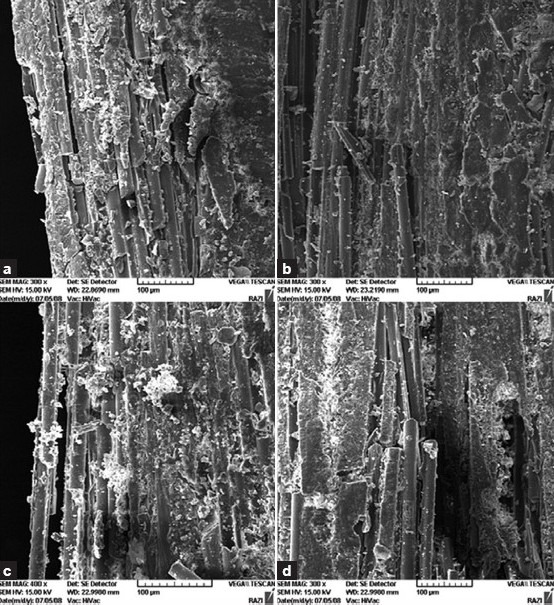
SEM micrographs of fractured surfaces of fiber-reinforce composites contained PMM-grafted nanocaly particles.(a) 0.5% wt nanofiller, (b) 0.2% wt nanofiller, (c) 1% wt nanofiller, (d) 5% wt nanofiller
SEM evaluation showed failure in resin matrix, fibers fracture, and fiber resin separation. Control group showed more deterioration.
DISCUSSION
The addition of unmodified nanoclay particles did not exert any statistically significant changes on the flexural strength of specimens compared to control group. Also, different subgroups did not represent significant differences. This is while the addition of poly methyl methacrylate-modified nanoclay particles that significantly increased the flexural strength compared to control group.
In different studies, it has been proposed that the addition of filers to resin matrix can improve the mechanical properties of resin-based materials.[24,25] It should be emphasized that the type of the fillers, their physical orientation, and their adherence capacity to the resin phase can affect the physical characteristics of resin-based materials.[26,27] According to the type of the filler, it can be suggested that the hydrophilic unmodified nanoparticles cannot be dispersed appropriately and will agglomerate in the resin phase. This phenomenon causes the stress to be concentrated on particular points in the resin phase and the crack to spread easily through the unfilled parts of matrix resin. This can be the main reason for crack propagation that leads to matrix fracture and reduction in flexural strength. These explanations clarify why unmodified nanoparticles did not cause significant changes in the flexural strength.
The appropriate separation and dispersion of filler particles in the resin matrix, especially in nanoscale, play an important role in the physical characteristics of resin-based materials. Surface modifications of nanoparticles can efficiently enhance their dispersion.[28] Swelling of the grafted polymeric chains on the modified nanoclay particles may reduce their density and facilitate their distribution in the resin phase by making them polarized. This uniform dispersion in nanoscale prevents crack propagation and causes a significant improvement in flexural strength properties.
Based on Li et al.'s[24] and Adabo et al.'s[29] studies, a significant enhancement was observed in flexural strength by increasing the amount of nanofillers and then the strength decreased subsequently by increasing the filler to higher amounts. In Bowen's study, results showed that by increasing the amount of nanoparticles more than a particular point, flexural strength will face a significant reduction.[30] These findings are in accordance with the results of the present study.
In the present study, in FRC groups containing modified nanoparticles, 0.2% wt subgroup showed the least amount of flexural strength and (but) the strength reached its highest value at 2% wt nanoparticles that was significantly different compared to other subgroups. By increasing the amount of filler to 5% wt, the strength dropped down consequently. This can be defined by the fact that overloading the resin phase by nanoparticles will increase the viscosity of resin phase that subsequently causes internal porosities in this phase and reduce its strength.[31,32] On the other hand, the viscous resin is not capable to wet the fibers properly that leads to a reduction in strength properties.
In the present study, in all subgroups containing unmodified nanoclay particles, a significant reduction was seen in flexural modulus except for 0.2% wt subgroup. Also, in modified nanoparticles group, the addition of 2% and 5% wt nanoclay significantly reduced the flexural modulus. Most studies have shown that an increase in flexural modulus would be the final consequence of filler addition to resin matrix.[17,27,33,34] Also, in Chisholm et al.'s study, it has been reported that the flexural modulus of resin matrix was significantly higher when they were impregnated by nanoparticles instead of macro fillers and it was explained by their higher surface energy.[35] In contrary to above mentioned studies, some studies indicate that the addition of fillers to some adhesives can decrease the flexural modulus[36] and some others declared that the size of the filers do not affect the flexural modulus.[9,19] In the present study, the addition of both modified and unmodified nanoparticles reduced the amount of flexural modulus compared to control group. A reduction which was seen by the addition of unmodified nanoparticles can be attributed to the hydrophilic feature of these particles that hinder their distribution in matrix phase. High percentage of fillers in modified group si gnificantly dropped down the flexural modulus which is in agreement with studies that declared the addition of fillers can affect the flexural modulus.[37]
In the present study, although the addition of 2% wt modified nanoparticles significantly improved the flexural strength, it significantly reduced the flexural modulus. So, it is recommended that further studies be conducted to investigate the effect of other concentrations of nanoparticles to improve all mechanical properties of FRCs spontaneously.
CONCLUSIONS
According to the results of the present study, it can be concluded that the addition of unmodified nanoparticles does not exert any significant effect on the mechanical features of FRCs. The amount of flexural strength reached its highest point by the addition of 2% wt PMMA-grafted nanoclay particles which improves the mechanical properties of FRCs and allows them to be used in more complex restorations.
Footnotes
Source of Support: This report is based on a thesis which was submitted to the School of Dentistry, Isfahan University of Medical Sciences, Isfahan, Iran, in partial fulfillment of the requirements for the MSc degree in Operative Dentistry (#386261). The study was approved by the Medical Ethics and Research Office at the Isfahan University of Medical Sciences and financially supported by this University
Conflict of Interest: The authors declare no conflicts of interest, real or perceived, financial or nonfinancial.
REFERENCES
- 1.Abdulmajeed AA, Närhi TO, Vallittu PK, Lassila LV. The effect of high fiber fraction on some mechanical properties of unidirectional glass fiber-reinforced composite. Dent Mater. 2011;27:313–21. doi: 10.1016/j.dental.2010.11.007. [DOI] [PubMed] [Google Scholar]
- 2.Woo S, Akeson W, Levenetz B, Coutts R, Matthews J, Amiel D. Potential application of graphite fiber and methyl methacrylate resin composites as internal fixation plates. J Biomed Mater Res. 1974;8:321–38. doi: 10.1002/jbm.820080513. [DOI] [PubMed] [Google Scholar]
- 3.Vallittu PK. Flexural properties of acrylic resin polymers reinforced with unidirectional and woven glass fibers. J Prosthet Dent. 1999;81:318–26. doi: 10.1016/s0022-3913(99)70276-3. [DOI] [PubMed] [Google Scholar]
- 4.Alander P, Lassila LV, Tezvergil A, Vallittu PK. Acoustic emission analysis of fiber-reinforced composite in flexural testing. Dent Mater. 2004;20:305–12. doi: 10.1016/S0109-5641(03)00108-8. [DOI] [PubMed] [Google Scholar]
- 5.Mortazavi V, Fathi MH, Katiraei N, Shahnaseri S, Badrian H, Khalighinejad N. Fracture resistance of structurally compromised and normal endodontically treated teeth restored with different post systems: An in vitro study. Dent Res J. 2012;9:185–91. doi: 10.4103/1735-3327.95234. [DOI] [PMC free article] [PubMed] [Google Scholar]
- 6.Friskopp J, Blomlof L. Intermediate fiberglass splints. J Prosthet Dent. 1984;51:334–7. doi: 10.1016/0022-3913(84)90216-6. [DOI] [PubMed] [Google Scholar]
- 7.Karbhari VM, Wang Q. Influence of triaxial braid denier on ribbon-based fiber reinforced dental composites. Dent Mater. 2007;23:969–76. doi: 10.1016/j.dental.2006.08.004. [DOI] [PubMed] [Google Scholar]
- 8.Vallittu P. Curing of a silane coupling agent and its effect on the transverse strength of autopolymerizing polymethylmethacrylate—glass fibre composite. J Oral Rehabil. 1997;24:124–30. doi: 10.1046/j.1365-2842.1997.00464.x. [DOI] [PubMed] [Google Scholar]
- 9.Janear J. Fiber reinforced thermoplastics for dentistry. Part 1. Hydrolytic stability of the inter face. J Mater Sci Mater Med. 1993;4:555–61. [Google Scholar]
- 10.Dyer SR, Lassila LVJ, Jokinen M, Vallittu PK. Effect of fiber position and orientation on fracture load of fiber-reinforced composite. Dent Mater. 2004;20:947–55. doi: 10.1016/j.dental.2003.12.003. [DOI] [PubMed] [Google Scholar]
- 11.Ellakwa A, Shortall A, Marquis P. Influence of fibre position on the flexural properties and strain energy of a fibre-reinforced composite. J Oral Rehabil. 2003;30:679–82. doi: 10.1046/j.1365-2842.2003.01121.x. [DOI] [PubMed] [Google Scholar]
- 12.Ballo A, Lassila L, Narhi T, Vallittu P. In vitro mechanical testing of glass fiber-reinforced composite used as dental implants. J Contemp Dent Pract. 2008;9:41–8. [PubMed] [Google Scholar]
- 13.Lee JH, Um CM, Lee IB. Rheological properties of resin composites according to variation in monomer and filler composition. Dent Mater. 2006;22:515–26. doi: 10.1016/j.dental.2005.05.008. [DOI] [PubMed] [Google Scholar]
- 14.Ellakwa A, Cho N, Lee IB. The effect of resin matrix composition on the polymerization shrinkage and rheological properties of experimental dental composite. Dent Mater. 2007;23:1229–35. doi: 10.1016/j.dental.2006.11.004. [DOI] [PubMed] [Google Scholar]
- 15.Tanimoto Y, Nishiwaki T, Nemoto K, Ben G. Effect of filler content on bending properties of dental composites: Numerical simulation with the use of the finite-element method. J Biomed Mater Res B Appl Biomater. 2004;71:188–95. doi: 10.1002/jbm.b.30079. [DOI] [PubMed] [Google Scholar]
- 16.Mousavinasab SM, Atai M, Alavi B. To Compare the Microleakage Among Experimental Adhesives Containing Nanoclay Fillers after the Storages of 24 Hours and 6 Month. Open Dent J. 2011;5:52–7. doi: 10.2174/1874210601105010052. [DOI] [PMC free article] [PubMed] [Google Scholar]
- 17.Kim JS, Cho BH, Lee IB, Um CM, Lim BS, Oh MH, et al. Effect of the hydrophilic nanofiller loading on the mechanical properties and the microtensile bond strength of an ethanol-based one-bottle dentin adhesive. J Biomed Mater Res B Appl Biomater. 2005;72:284–91. doi: 10.1002/jbm.b.30153. [DOI] [PubMed] [Google Scholar]
- 18.Chivrac F, Gueguen O, Pollet E, Ahzi S, Makradi A, Averous L. Micromechanical modeling and characterization of the effective properties in starch-based nano-biocomposites. Acta Biomater. 2008;4:1707–14. doi: 10.1016/j.actbio.2008.05.002. [DOI] [PubMed] [Google Scholar]
- 19.DePolo W, Baird D. Particulate reinforced PC/PBT composites. II. Effect of nano-clay particles on dimensional stability and structure-property relationships. Polym Compos. 2009;30:200–13. [Google Scholar]
- 20.Solhi L, Atai M, Nodehi A, Imani M, Ghaemi A, Khosravi K. Poly (acrylic acid) grafted montmorillonite as novel fillers for dental adhesives: Synthesis, characterization and properties of the adhesive. Dent Mater. 2012;28:369–77. doi: 10.1016/j.dental.2011.11.010. [DOI] [PubMed] [Google Scholar]
- 21.Paul DR, Robeson LM. Polymer nanotechnology: Nanocomposites. Polymer (Guildf) 2008;49:3187–204. [Google Scholar]
- 22.Atai M, Solhi L, Nodehi A, Mirabedini SM, Kasraei S, Akbari K. PMMA-grafted nanoclay as novel filler for dental adhesives. Dent Mater. 2009;25:339–47. doi: 10.1016/j.dental.2008.08.005. [DOI] [PubMed] [Google Scholar]
- 23.Conde MC, Zanchi CH, Rodrigues-Junior SA, Carreño NL, Ogliari FA, Piva E. Nanofiller loading level: Influence on selected properties of an adhesive resin. J Dent. 2009;37:331–5. doi: 10.1016/j.jdent.2009.01.001. [DOI] [PubMed] [Google Scholar]
- 24.Li Y, Swartz M, Phillips R, Moore B, Roberts T. Materials science effect of filler content and size on properties of composites. J Dent Res. 1985;64:1396–403. doi: 10.1177/00220345850640121501. [DOI] [PubMed] [Google Scholar]
- 25.Montes MA, de Goes MF, da Cunha MR, Soares AB. A morphological and tensile bond strength evaluation of an unfilled adhesive with low-viscosity composites and a filled adhesive in one and two coats. J Dent. 2001;29:435–41. doi: 10.1016/s0300-5712(01)00037-9. [DOI] [PubMed] [Google Scholar]
- 26.Ikejima I, Nomoto R, McCabe JF. Shear punch strength and flexural strength of model composites with varying filler volume fraction, particle size and silanation. Dent Mater. 2003;19:206–11. doi: 10.1016/s0109-5641(02)00031-3. [DOI] [PubMed] [Google Scholar]
- 27.Nunes M, Swift E, Perdigão J. Effects of adhesive composition on microtensile bond strength to human dentin. Am J Dent. 2001;14:340–3. [PubMed] [Google Scholar]
- 28.Allen NS, Edge M, Ortega A, Sandoval G, Liauw CM, Verran J, et al. Degradation and stabilisation of polymers and coatings: Nano versus pigmentary titania particles. Polym Degrad Stab. 2004;85:927–46. [Google Scholar]
- 29.Adabo GL, dos Santos Cruz CA, Fonseca RG, Vaz LG. The volumetric fraction of inorganic particles and the flexural strength of composites for posterior teeth. J Dent. 2003;31:353–9. doi: 10.1016/s0300-5712(03)00049-6. [DOI] [PubMed] [Google Scholar]
- 30.Bowen R. Effect of particle shape and size distribution in a reinforced polymer. J Am Dent Assoc. 1964;69:481–95. doi: 10.14219/jada.archive.1964.0318. [DOI] [PubMed] [Google Scholar]
- 31.Mitra SB, Wu D, Holmes BN. An application of nanotechnology in advanced dental materials. J Am Dent Assoc. 2003;134:1382–90. doi: 10.14219/jada.archive.2003.0054. [DOI] [PubMed] [Google Scholar]
- 32.Xu H. Whisker-reinforced heat-cured dental resin composites: Effects of filler level and heat-cure temperature and time. J Dent Res. 2000;79:1392–7. doi: 10.1177/00220345000790060701. [DOI] [PubMed] [Google Scholar]
- 33.Kemp-Scholte CM, Davidson C. Complete marginal seal of Class V resin composite restorations effected by increased flexibility. J Dent Res. 1990;69:1240–3. doi: 10.1177/00220345900690060301. [DOI] [PubMed] [Google Scholar]
- 34.Van Meerbeek B, Willems G, Celis JP, Roos J, Braem M, Lambrechts P, et al. Assessment by nano-indentation of the hardness and elasticity of the resin-dentin bonding area. J Dent Res. 1993;72:1434–42. doi: 10.1177/00220345930720101401. [DOI] [PubMed] [Google Scholar]
- 35.Chisholm N, Mahfuz H, Rangari VK, Ashfaq A, Jeelani S. Fabrication and mechanical characterization of carbon/SiC-epoxy nanocomposites. Compos Struct. 2005;67:115–24. [Google Scholar]
- 36.Takahashi A, Sato Y, Uno S, Pereira P, Sano H. Effects of mechanical properties of adhesive resins on bond strength to dentin. Dent Mater. 2002;18:263–8. doi: 10.1016/s0109-5641(01)00046-x. [DOI] [PubMed] [Google Scholar]
- 37.Jiang L, Lam YC, Tam KC, Chua TH, Sim GW, Ang LS. Strengtheningacrylonitrile-butadiene-styrene (ABS) with nano-sized and micron-sized calcium carbonate. Polymer (Guildf) 2005;46:243–52. [Google Scholar]


